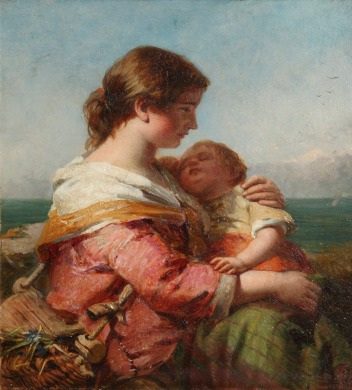
Mothering Sunday was once the day on which people would visit their “mother” church, but has now become an occasion for honouring the mothers of children.
This year it will be celebrated on Sunday 26th March and we pay tribute to the unconditional love of mothers everywhere by examining this charming portrait by Birmingham born artist J J Hill. His style was playful and romantic and was reminiscent of the Rococo artists popular in France during the eighteenth century. Hill painted works that were unchallenging and which appealed to a populist audience. This brought him huge success during his own lifetime. Copies of his works were highly sought after and many magazines and newspapers of the period published his work to an appreciative audience.
One of Hill’s fans was the hugely wealthy philanthropist Lady Burdett-Coutts, for whom he painted many portraits along with animal and dog studies. The subjects he returned to most regularly were portraits of women, frequently depicted tenderly holding their children. This touching portrait of mother and sleeping child captivated George Holt, then owner of Sudley House. There is no hidden message in this work, only the gentle love between mother and child. From her costume and accoutrements, we can tell the woman is a simple peasant girl. But the artist makes no comment on her status in life. Instead he treats her with the same gentleness and warmth with which she treats her sleeping child. She is portrayed with reverence and grace as if the artist had painted the Madonna and Child. Like mothers everywhere she is grateful for a quiet moment whilst her baby sleeps. Her gaze, wistfully wanders off into the distance, as she contemplates what the future will hold for herself and her baby.
‘Mother and Child’ can be seen hanging in the library of Sudley House. Sudley House is located on Mossley Hill Road near Liverpool and is open daily from 10am to 5pm, admission is free.
Image © National Museums Liverpool
Why you should see this painting: This charming painting reminds us that throughout history, regardless of culture or wealth, a mother’s love remains constant and unconditional.
First published in Cheshire Life March 2017